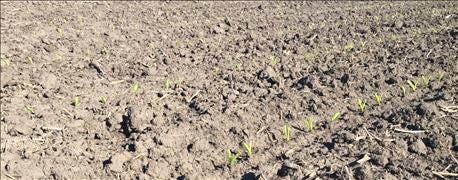
Sunshine and patience. That’s what Brent Tharp, Wyffels Hybrids agronomy and product training manager said farmers need after a week of cold and rain. Once heavily saturated fields, or fields with ponding, have a few warm days to recover it’s time to assess emergence.
“There is no hard and fast rule about how long a corn plant can survive without oxygen,” Tharp explained. “But, 24-48 hours of complete saturation and lack of oxygen is not good on a corn plant.”

FIELD CHECK: Brent Tharp, Wyffels Hybrids agronomy and product training manager, said farmers should check individual corn plants for seedling disease and take an overall stand count. Fields recovering from heavy rain or ponding are a priority for scouting.
Tharp recommended digging up plants and inspecting them from top to bottom: the growing point, the mesocotyl, the seminal roots and the radicle. “You’re looking for discoloration, brown, rotting parts of the plant,” Tharp noted. “If you’re not seeing any of that, the plants will come out of it.” Brown and rotten plant tissue is an indication of seedling disease. White or yellow colors throughout the plant are signs of healthy tissue.
After inspecting individual plants, compare emerged seedlings in the field. Tharp explained a field with plants in various stages, ranging from V1 or first leaf to emerging or spiking, is a sign of future issues. “When you have plants at uneven growth stages, the bigger plants will out compete the smaller plants,” Tharp said.
What’s causing the uneven emergence? Tharp said cold stress during germination can cause corkscrewing of the mesocotyl or leafing out underground. “That’s not a good sign,” Tharp noted. “Even if the plants emerge, they won’t be productive.”
What to do?

EMERGENCE ISSUES: Tharp said cold stress during germination can cause corkscrewing of the mesocotyl or leafing out underground
If farmers identify emergence issues, then it’s time to look at the big picture. “Farmers should take a stand count and evaluate the number of healthy plants and weigh that against the calendar date,” Tharp said. “If you lose 10% stand, that 90% good stand could be better than trying to replant.”
Tharp said corn plants he’s evaluated so far look good. “It’s slow, but that’s normal. Corn can sit in the ground quite a while,” Tharp explained. “It takes anywhere from 90-120 GDUs for emergence, but that’s based on air temp. The soil temperature acts as a buffer.” In some instances, 130 GDUs may accumulate before emergence. And even with a slow start, the end result may not be impacted.
“The plant isn’t determining yield at this stage,” Tharp said. “We’re determining yield in a sense of uniform stand. If plants grow slowly, but evenly, it shouldn’t affect yield.”
Tharp is confident corn plants will recover from the cold and rainy start. Soil temperatures didn’t fall below 40 degrees and a few days of sun and warmth will make a significant difference. Tharp still recommends taking time to scout fields for trouble spots.
“Checking for even and uniform emergence really is important,” Tharp noted. “The longer it takes for plants to emerge, the more time seedling disease can work on the plant. “
About the Author(s)
You May Also Like




